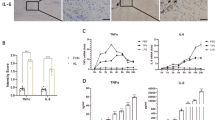Abstract
The adverse biological responses to prostheses wear particles commonly led to the failure of total hip arthroplasty. Among the released cytokines, interferon-γ (IFN-γ) has been found to be a critical functional factor during osteoclast differentiation. However, the molecular mechanism underlying the regulation of IFN-γ in wear particles-induced cells still needs to be determined. Four kinds of abrasive endoprosthetic wear particle were used to treat THP-1 cells, including polymethylmethacrylate (PMMA), zirconiumoxide (ZrO2), commercially pure titanium (cpTi), and titanium alloy (Ti-6Al-7Nb), with a concentration of 0.01, 0.05, 0.1, or 0.2 mg/ml for 48 h. The expression of IFN-γ and miR-29b was detected by real-time RT-PCR or ELISA. Luciferase reporter assay was performed to determine the regulation of miR-29b on IFN-γ. The effect of miR-29b inhibitor on the expression of wear particle-induced IFN-γ was detected. The expression of miR-29b was examined in THP-1 cells treated with tumor necrosis factor-alpha (TNF-α). The expression of IFN-γ was downregulated and the level of miR-29b was increased in THP-1 cells pretreated with wear particles. IFN-γ was a target of miR-29b. Wear particles inhibited the expression of IFN-γ through miR-29b. The expression of miR-29b was significantly reduced in THP-1 cells treated with TNF-α neutralizing antibody and particles comparing to that in the cells treated with particles alone. Wear particles inhibit the IFN-γ secretion in human monocytes, which was associated with the upregulating TNF-α-induced miR-29b.




Similar content being viewed by others
REFERENCES
Ulrich, S.D., et al. 2008. Total hip arthroplasties: what are the reasons for revision? International Orthopaedics 32(5): 597–604.
Howie, D.W., et al. 2013. Periprosthetic osteolysis after total hip replacement: molecular pathology and clinical management. Inflammopharmacology 21(6): 389–396.
Goodman, S., et al. 2014. Novel biological strategies for treatment of wear particle-induced periprosthetic osteolysis of orthopaedic implants for joint replacement. Journal of the Royal Society, Interface 11(93): 20130962.
Schroder, K., et al. 2004. Interferon-γ: an overview of signals, mechanisms and functions. Journal of Leukocyte Biology 75(2): 163–189.
Kohara, H., et al. 2011. IFN-γ directly inhibits TNF-α-induced osteoclastogenesis in vitro and in vivo and induces apoptosis mediated by Fas/Fas ligand interactions. Immunology Letters 137(1): 53–61.
Ji, J.-D., et al. 2009. Inhibition of RANK expression and osteoclastogenesis by TLRs and IFN-γ in human osteoclast precursors. The Journal of Immunology 183(11): 7223–7233.
Honma, M., et al. 2014. Regulatory mechanisms of RANKL presentation to osteoclast precursors. Current Osteoporosis Reports 12(1): 115–120.
Li, P., et al. 2016. Interferon-γ enhances the efficacy of autogenous bone grafts by inhibiting postoperative bone resorption in rat calvarial defects. Journal of Prosthodontic Research.
Lian, J.B., et al. 2012. MicroRNA control of bone formation and homeostasis. Nature Reviews Endocrinology 8(4): 212–227.
Schoolmeesters, A., et al. 2009. Functional profiling reveals critical role for miRNA in differentiation of human mesenchymal stem cells. PloS One 4(5): e5605.
Zhou, Y., Y. Liu, and L. Cheng. 2012. miR‐21 expression is related to particle‐induced osteolysis pathogenesis. Journal of Orthopaedic Research 30(11): 1837–1842.
Suh, J.S., et al. 2013. Peptide-mediated intracellular delivery of miRNA-29b for osteogenic stem cell differentiation. Biomaterials 34(17): 4347–4359.
Kagiya, T., and S. Nakamura. 2013. Expression profiling of microRNAs in RAW264. 7 cells treated with a combination of tumor necrosis factor alpha and RANKL during osteoclast differentiation. Journal of Periodontal Research 48(3): 373–385.
Noordin, S., and B. Masri. 2012. Periprosthetic osteolysis: genetics, mechanisms and potential therapeutic interventions. Canadian Journal of Surgery 55(6): 408.
Cheng, J., et al. 2012. Molecular mechanisms of the biphasic effects of interferon-γ on osteoclastogenesis. Journal of Interferon & Cytokine Research 32(1): 34–45.
Haynes, D.R., et al. 1998. Variation in cytokines induced by particles from different prosthetic materials. Clinical Orthopaedics & Related Research 352(352): 223–30.
Lochner, K., et al. 2011. The potential role of human osteoblasts for periprosthetic osteolysis following exposure to wear particles. International Journal of Molecular Medicine 28(6): 1055–63.
Lin, T.H., et al. 2015. Exposure of polyethylene particles induces interferon‐γ expression in a natural killer T lymphocyte and dendritic cell coculture system in vitro: A preliminary study. Journal of Biomedical Materials Research. Part A 103(1): 71–75.
Takayanagi, H., et al. 2005. Interplay between interferon and other cytokine systems in bone metabolism. Immunological Reviews 208(1): 181–193.
Duque, G., et al. 2011. Interferon‐γ plays a role in bone formation in vivo and rescues osteoporosis in ovariectomized mice. Journal of Bone and Mineral Research 26(7): 1472–1483.
Rossi, M., et al. 2013. miR‐29b negatively regulates human osteoclastic cell differentiation and function: Implications for the treatment of multiple myeloma‐related bone disease. Journal of Cellular Physiology 228(7): 1506–1515.
Abuna, R.P., et al. 2016. Participation of TNF‐α in Inhibitory Effects of Adipocytes on Osteoblast Differentiation. Journal of Cellular Physiology 231(1): 204–214.
Azuma, Y., et al. 2000. Tumor necrosis factor-α induces differentiation of and bone resorption by osteoclasts. Journal of Biological Chemistry 275(7): 4858–4864.
Kitaura, H., et al. 2013. Immunological reaction in TNF-α-mediated osteoclast formation and bone resorption in vitro and in vivo. Clinical and Developmental Immunology. 2013.
Liu, N., et al. 2016. Autophagy mediated TiAl 6 V 4 particle-induced peri-implant osteolysis by promoting expression of TNF-α. Biochemical and Biophysical Research Communications 473(1): 133–139.
Schwarz, E.M., R.J. Looney, and R.J. O'Keefe. 2000. Anti-TNF-α therapy as a clinical intervention for periprosthetic osteolysis. Arthritis Research & Therapy 2(3): 1.
Author information
Authors and Affiliations
Corresponding author
Ethics declarations
Conflict of Interest
The authors declare no actual or potential conflicts of interest.
Rights and permissions
About this article
Cite this article
Bu, Ym., Zheng, Dz., Wang, L. et al. Abrasive Endoprosthetic Wear Particles Inhibit IFN-γ Secretion in Human Monocytes Via Upregulating TNF-α-Induced miR-29b. Inflammation 40, 166–173 (2017). https://doi.org/10.1007/s10753-016-0465-5
Published:
Issue Date:
DOI: https://doi.org/10.1007/s10753-016-0465-5




